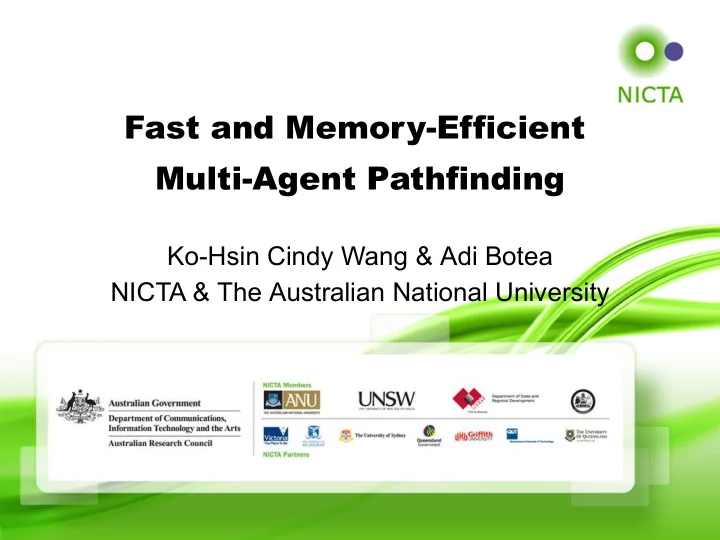

Fast and Memory-Efficient Multi-Agent Pathfinding Ko-Hsin Cindy Wang & Adi Botea NICTA & The Australian National University
Outline The multi-agent path planning problem + applications Related work Our method: FAR – Flow Annotation Replanning Results Ko-Hsin Cindy Wang & Adi Botea 2
Multi-Agent Path Planning Multiple mobile units. Shared environment. Static obstacles in the environment. Dynamic obstacles: other units. Navigate every unit to its target. Image source: A difficult problem: http://www.supremecommander.com/ PSPACE-hard [Hopcroft et al. 1984]. Often, needs to be solved in real time. Ko-Hsin Cindy Wang & Adi Botea 3
Applications Robotics motion planning Air traffic control Vehicle routing Disaster rescue Military operation planning Computer games Ko-Hsin Cindy Wang & Adi Botea 4
Related Work Centralised approaches: – (theoretically) optimal – scale up poorly in practice – e.g. Randomized Path Planner (RPP) [Barraquand & Latombe 1989] Decentralised approaches: – decompose into subproblems – typically faster, sub-optimal, incomplete – e.g. Windowed Hierarchical Cooperative A* (WHCA*) [Silver 2006], enhanced with spatial abstraction in [Sturtevant & Buro 2006]; Subgraph abstraction & planning [Ryan 2008] Ko-Hsin Cindy Wang & Adi Botea 5
Problem Definition Grid maps. Tiles: accessible ( free or occupied ); blocked. Homogenous agents, uniform speed. A legal move: Distance travelled: Baldur's Gate – 1 for a cardinal move, Map AR0700 (320x320 tiles) – sqrt(2) for a diagonal move. Ko-Hsin Cindy Wang & Adi Botea 6
The FAR Method 1. Build a flow-annotated search graph . 2. Run a complete A* search for each unit independently. 3. Execute the plan: Avoid replanning; Otherwise, do local plan repair. Ko-Hsin Cindy Wang & Adi Botea 7
Flow-Annotated Search Graph (1) Step 1. Abstract the grid map into a directed graph with controlled navigation flow: Directed edges. Alternate horizontal/vertical flows to adjacent rows/columns. Cover entire grid with criss-crossing virtual roads. Initially, no diagonals. Ko-Hsin Cindy Wang & Adi Botea 8
Map Connectivity Ko-Hsin Cindy Wang & Adi Botea 9
Flow-Annotated Search Graph (2) Step 2. Additional rules ensure all adjacent nodes remain connected both ways. Single-width tunnel: bi-directional. Source / sink nodes: – add a diagonal incoming/outgoing edge. – if leading to another source/sink, make edges bi-directional instead. Ko-Hsin Cindy Wang & Adi Botea 10
Search and Execution Try to avoid replanning: – favour straighter paths on equal f -values. – temporal reservation: (x,y,t) for k steps ahead. – waiting. – traffic lights: temporal flow regulation. Otherwise, when replanning has to be done: – local replanning. – detect and break deadlocks . Ko-Hsin Cindy Wang & Adi Botea 11
Deadlock Procedures An arbitrary size cycle of units waiting for each other to move [Coffman et al. 1971]: Deadlock detection launched frequently: to identify and fix deadlocks early. Deadlock breaking: a critical unit takes a small detour. Ko-Hsin Cindy Wang & Adi Botea 12
Critical Unit Selection Node density : # computed paths passing through a node. For a unit in deadlock, the higher the density at its location, the more units are blocked. Select a unit at the highest density node. Ko-Hsin Cindy Wang & Adi Botea 13
Deadlock Breaking Procedure After selecting a critical unit, u' Let u' take a step away from the deadlock, respecting the flow annotation, Then u' replans its way back at the next time step, Meanwhile, units blocked by u' have a chance to pass through. Ko-Hsin Cindy Wang & Adi Botea 14
Experimental Setup 2.8GHz Intel Core 2 Duo Mac, 2GB RAM. 10 largest maps from Baldur's Gate - a standard data set. For each map, increase N , the number of mobile units, by 100 at a time . Generate 10 problem instances for each N . Time limit set to 10 minutes per problem. k = 3. Compared with WHCA*(8,1), with and without diagonals [Silver 2005; Sturtevant & Buro 2006]. Run on the Hierarchical Open Graph framework (HOG) http://www.cs.ualberta.ca/~nathanst/hog.html Ko-Hsin Cindy Wang & Adi Botea 15
Baldur's Gate Maps Ko-Hsin Cindy Wang & Adi Botea 16
AR0411SR 272x232 tiles 14098 traversable tiles Ko-Hsin Cindy Wang & Adi Botea 17
Ko-Hsin Cindy Wang & Adi Botea 18
Ko-Hsin Cindy Wang & Adi Botea 19
Ko-Hsin Cindy Wang & Adi Botea 20
Ko-Hsin Cindy Wang & Adi Botea 21
Ko-Hsin Cindy Wang & Adi Botea 22
Future Work Investigate new heuristics, better waiting strategies, smarter annotations/dynamic flows. Analytical studies. Incorporate FAR into a real game, or enter RoboCup Rescue. Extend FAR for: planning under uncertainty; initially unknown maps; dynamic environments; moving targets. Ko-Hsin Cindy Wang & Adi Botea 23
Summary FAR builds a flow-annotated search graph inspired by two- way roads. Replanning is done locally, keeping the computations cheap. FAR solves problems more quickly and uses less memory than WHCA*. FAR can often solve problems with larger number of units. Simple approaches can be very effective in many cases. Questions? ☺ Ko-Hsin Cindy Wang & Adi Botea 24
Recommend
More recommend